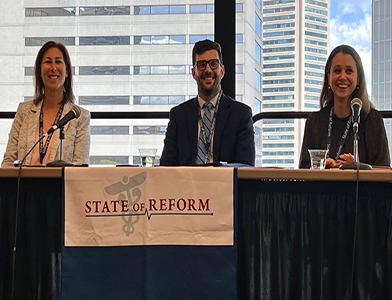State of Reform: Policy Opportunities to Lower the Cost of Prescription Drugs
 How will Medicare drug price negotiation impact Marylanders? How are state initiatives, such as the Maryland Prescription Drug Affordability Board, reducing drug costs? On June 14, the Maryland State of Reform Conference held a panel discussion, Methods to Lower the Cost of Drugs, to address these key issues and more.
How will Medicare drug price negotiation impact Marylanders? How are state initiatives, such as the Maryland Prescription Drug Affordability Board, reducing drug costs? On June 14, the Maryland State of Reform Conference held a panel discussion, Methods to Lower the Cost of Drugs, to address these key issues and more.
During the discussion, CareFirst BlueCross BlueShield’s (CareFirst) Vice President of Pharmacy Management, Mandi Poplawski, was joined by Mariana Socal, M.D., Ph.D., Associate Scientist at Johns Hopkins Bloomberg School of Public Health and Andrew York, J.D., PharmD, Executive Director of the Maryland Prescription Drug Affordability Board. Poplawski kicked off the discussion by highlighting how prescription drugs account for nearly 1 in every 3 dollars CareFirst spends on member claims—primarily driven by specialty medications. While only 3.8% of CareFirst members take specialty medications, they comprise more than 54% of CareFirst drug spending.
The need to address the rising cost of specialty medications, which typically require special storage, handling and patient education, is not new. According to a recent report from the United States Department of Health and Human Services, the “cost of specialty drugs has continued to grow, totaling $301 billion in 2021, an increase of 43% since 2016.” One of the reasons drug prices increase over time is due to longstanding patent protections in federal law, which delay generic and biosimilar entry into the market. CareFirst advocates that federal policymakers address unfair practices, such as evergreening, pay-for-delay, and blocking access to branded products needed to develop generics.
In 2022, Congress approved landmark legislation, the Inflation Reduction Act of 2022 (IRA), to tackle this issue by authorizing Medicare to directly negotiate the price of single-source drugs past their exclusivity period. This is important because these drugs have been on the market for years yet lack generic or biosimilar competition, allowing the drug manufacturer to keep list prices high. While CareFirst continues to advocate for this negotiation to apply to commercial markets to ensure greater impact, this provision, as written, will still increase price transparency and hopefully slow the trend in list price growth. This provision in the IRA will ideally be complemented by the work of Maryland’s Prescription Drug Affordability Board, which has the authority to set upper payment limits for certain high-cost drugs.
Another key theme during the State of Reform was addressing the high cost of certain generics and other commonly used medications such as insulin. In the IRA, Congress created a $35/month copay cap on insulin for Medicare beneficiaries, which CareFirst strongly supported. We proactively implemented $0 cost-sharing for preferred insulin and diabetic supplies in 2021 for fully insured members. This initiative has lowered out-of-pocket costs, improved patient outcomes, and advanced health equity. CareFirst believes costs should not be a barrier to access and is continuing to explore other initiatives to help ensure our members have access to high-quality medications and other therapies.
As policymakers consider options to lower prescription drug prices, CareFirst believes direct government intervention is necessary. As currently constructed, the private market will continue to support the status quo, driven by incentives to keep drug prices high. Everyone should be able to get the medications they need at a price they can afford, and CareFirst will continue to do our part to ensure affordable access for our members.
Click here to learn more about CareFirst’s recent panel discussion on June 29, “Curing What Ails Prescription Drugs: Exploring Policy Solutions that are Increasing Access and Affordability.”